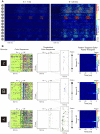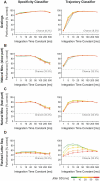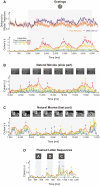Timescales of multineuronal activity patterns reflect temporal structure of visual stimuli
- PMID: 21346812
- PMCID: PMC3035626
- DOI: 10.1371/journal.pone.0016758
Timescales of multineuronal activity patterns reflect temporal structure of visual stimuli
Abstract
The investigation of distributed coding across multiple neurons in the cortex remains to this date a challenge. Our current understanding of collective encoding of information and the relevant timescales is still limited. Most results are restricted to disparate timescales, focused on either very fast, e.g., spike-synchrony, or slow timescales, e.g., firing rate. Here, we investigated systematically multineuronal activity patterns evolving on different timescales, spanning the whole range from spike-synchrony to mean firing rate. Using multi-electrode recordings from cat visual cortex, we show that cortical responses can be described as trajectories in a high-dimensional pattern space. Patterns evolve on a continuum of coexisting timescales that strongly relate to the temporal properties of stimuli. Timescales consistent with the time constants of neuronal membranes and fast synaptic transmission (5-20 ms) play a particularly salient role in encoding a large amount of stimulus-related information. Thus, to faithfully encode the properties of visual stimuli the brain engages multiple neurons into activity patterns evolving on multiple timescales.
Conflict of interest statement
Figures





Similar articles
-
Stimulus-dependent oscillations in the cat visual cortex: differences between bar and grating stimuli.Brain Res. 1996 Aug 26;731(1-2):91-100. doi: 10.1016/0006-8993(96)00468-4. Brain Res. 1996. PMID: 8883858
-
Attention Increases Spike Count Correlations between Visual Cortical Areas.J Neurosci. 2016 Jul 13;36(28):7523-34. doi: 10.1523/JNEUROSCI.0610-16.2016. J Neurosci. 2016. PMID: 27413161 Free PMC article.
-
Synaptic origin and stimulus dependency of neuronal oscillatory activity in the primary visual cortex of the cat.J Physiol. 1997 May 1;500 ( Pt 3)(Pt 3):751-74. doi: 10.1113/jphysiol.1997.sp022056. J Physiol. 1997. PMID: 9161989 Free PMC article.
-
Burst firing and modulation of functional connectivity in cat striate cortex.J Neurophysiol. 1998 Aug;80(2):730-44. doi: 10.1152/jn.1998.80.2.730. J Neurophysiol. 1998. PMID: 9705464
-
Visual orientation and directional selectivity through thalamic synchrony.J Neurosci. 2012 Jun 27;32(26):9073-88. doi: 10.1523/JNEUROSCI.4968-11.2012. J Neurosci. 2012. PMID: 22745507 Free PMC article.
Cited by
-
Distinct Inhibitory Circuits Orchestrate Cortical beta and gamma Band Oscillations.Neuron. 2017 Dec 20;96(6):1403-1418.e6. doi: 10.1016/j.neuron.2017.11.033. Neuron. 2017. PMID: 29268099 Free PMC article.
-
Primary visual cortex represents the difference between past and present.Cereb Cortex. 2015 Jun;25(6):1427-40. doi: 10.1093/cercor/bht318. Epub 2013 Dec 15. Cereb Cortex. 2015. PMID: 24343889 Free PMC article.
-
Hold Your Methods! How Multineuronal Firing Ensembles Can Be Studied Using Classical Spike-Train Analysis Techniques.Front Syst Neurosci. 2019 May 17;13:21. doi: 10.3389/fnsys.2019.00021. eCollection 2019. Front Syst Neurosci. 2019. PMID: 31156401 Free PMC article.
-
Analysis of slow (theta) oscillations as a potential temporal reference frame for information coding in sensory cortices.PLoS Comput Biol. 2012;8(10):e1002717. doi: 10.1371/journal.pcbi.1002717. Epub 2012 Oct 11. PLoS Comput Biol. 2012. PMID: 23071429 Free PMC article.
-
The fractal brain: scale-invariance in structure and dynamics.Cereb Cortex. 2023 Apr 4;33(8):4574-4605. doi: 10.1093/cercor/bhac363. Cereb Cortex. 2023. PMID: 36156074 Free PMC article. Review.
References
-
- Perkel D, Bullock TH. Neural coding. Neurosci Res Prog Bulletin. 1968;6:221–348.
-
- Eggermont JJ. Is there a neural code? Neurosci Biobehav Rev. 1998;22:355–370. - PubMed
-
- Adrian ED. New York: W.W. Norton & Co; 1928. The basis of sensation: the action of the sense organs.
-
- Singer W. Neuronal synchrony: a versatile code for the definition of relations? Neuron. 1999;24:49–65, 111-25. - PubMed
Publication types
MeSH terms
LinkOut - more resources
Full Text Sources
Miscellaneous

